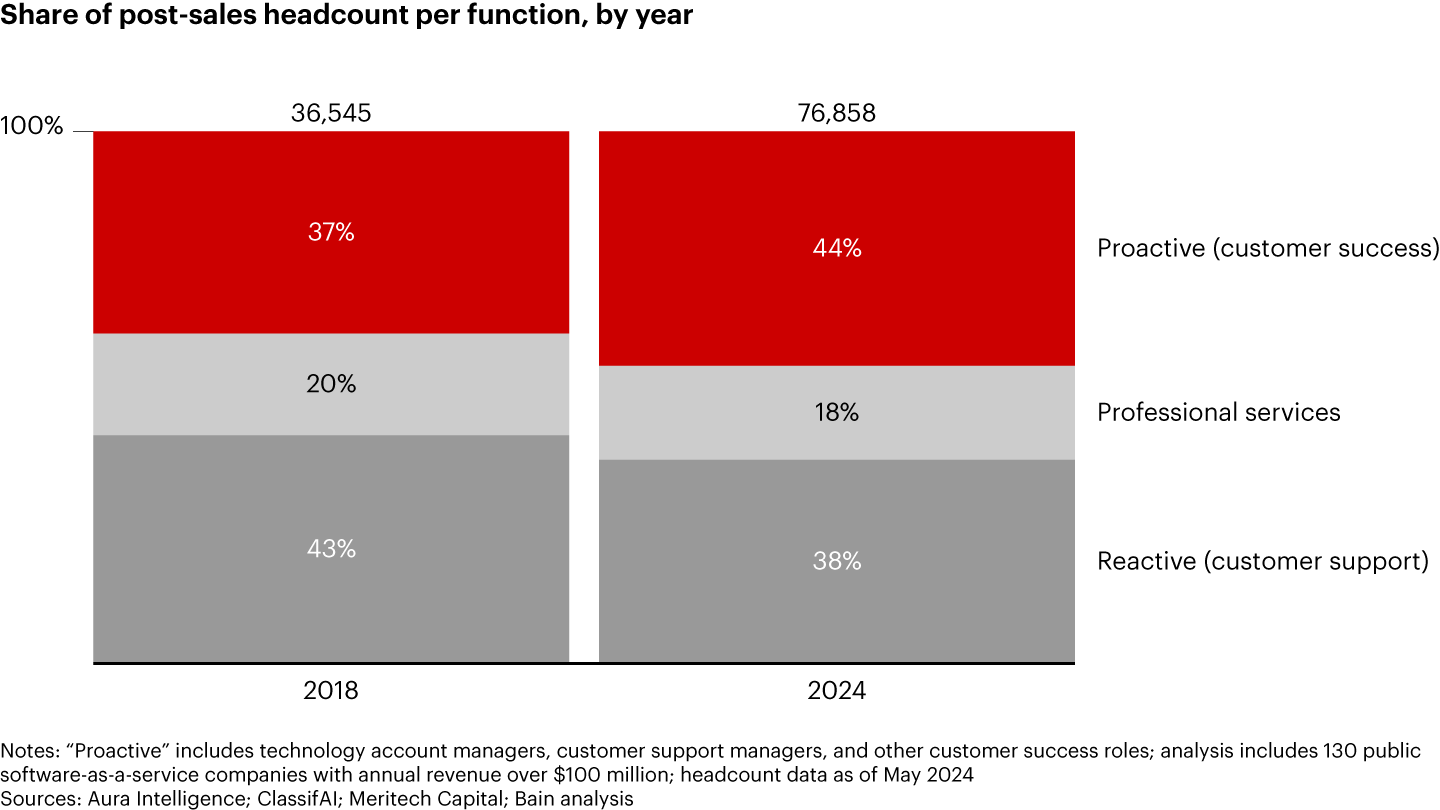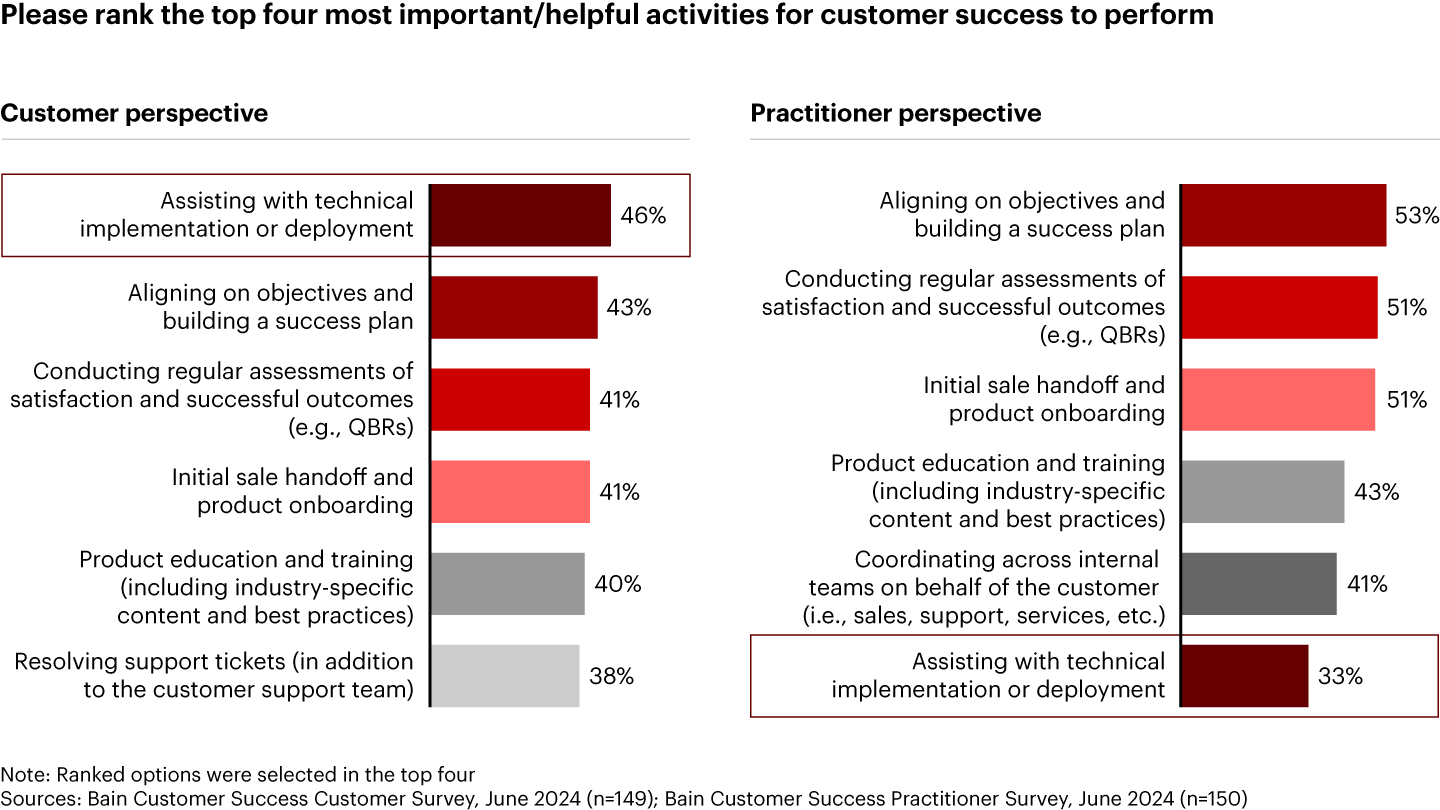Technology Report

Резюме
- Despite increased customer success investments, net revenue retention rates have declined for 75% of software firms in a recent Bain survey.
- In addition, nearly two-thirds of software customers feel their post-sales needs are only being moderately addressed or worse.
- There’s a mismatch between how vendors provide support and what customers value, particularly in technical implementation assistance.
- Leading firms are developing a clear product and customer journey blueprint, better defining and coordinating post-sales roles, and investing in AI-enabled self-service tools.
This article is part of Bain's 2024 Technology Report.
Software companies are grappling with a surprising disconnect: Despite significant investments in post-sales personnel since the pandemic, customer retention has suffered. Net revenue retention (NRR) rates, a measure of how well companies retain and expand revenue from existing customers over a certain period, decreased for 75% of software companies in a recent Bain survey, even as nearly 60% increased customer success spending (see Figure 1). Frustrated executives are questioning why these investments haven’t paid off and, worse yet, may have exacerbated the problem.
It turns out a huge disconnect exists between how customers want to be served and what vendors think they need. Additionally, many vendors silo the customer success function and miss the opportunity of a streamlined post-sales package with cohesion across tech support, customer success, and professional services.
Effective post-sales activities help buyers implement software, increase adoption, adapt their use as needed, and achieve ROI, all of which are more important than ever with the acceleration of software purchases during the pandemic and the increasing complexity of software-as-a-service (SaaS) products. Slowing post-pandemic sales and a shift from subscription- to customer usage-based pricing have further raised the stakes for retaining customers and enticing them to spend more.
Software vendors have largely relied on customer success teams to maximize product use. In addition to customer success practitioners’ increased spending, more software companies are creating a dedicated customer success team. The share of US enterprise software companies with a customer success team reached 60% this year, up from about 40% four years ago, according to Bain analysis of LinkedIn and other data.
To deepen customer relationships, vendors have also emphasized more proactive, specialized customer success roles, including customer success managers, technical account managers, and success architects. Meanwhile, they’ve reduced spending on reactive tech support roles through automation, which generative AI could further accelerate. Consequently, customer success roles now constitute a larger portion of the post-sales workforce (see Figure 2).


However, these investments haven’t delivered the desired results. Software vendors’ deteriorating NRR rates align with our customer success survey data: nearly two-thirds of software customers feel their post-sales needs are only being moderately addressed or worse (see Figure 3).


Why? Our research found a mismatch between how vendors provide support and what customers value. In our recent survey, software buyers ranked assistance with technical implementation or deployment as their highest priority for customer success, while practitioners ranked it sixth (see Figure 4). Vendors often provide general assistance but have abdicated too much technical implementation to systems integration partners. Clearly, customers see a role for vendors to provide architectural support and technical implementation best practices, even if systems integrators continue to do the heavy lifting.


Another disconnect is that customers prefer a technical role as their primary contact for customer success, while vendors often assign a non-technical customer success manager instead, according to our survey.
To be fair, customer success functions face intense pressure due to a broader push to reduce IT costs, increased scrutiny of internal budgets, and client procurement teams challenging add-on services such as paid, premium customer success offerings. These headwinds are compounding two long-standing challenges: It remains difficult to prove the return on customer success investments, and many of these teams are perceived as cost centers rather than revenue generators.
That said, many vendors have hired excessively in customer success without validating their post-sales model, missing opportunities to deploy all post-sales functions more efficiently.
What does good look like?
Based on our work with software companies worldwide and analysis of companies with high NRR, we’ve found that the emerging leaders are focusing on the following key steps.
- Step into your customer’s shoes. Emerging leaders first map how customers interact with and derive value from the product, followed by mapping the broader customer journey from initial consideration through purchase, post-sales support, and renewal. It sounds like a given, but many companies’ product and engineering teams don’t articulate what the product’s value realization journey looks like or work to deeply understand customers’ needs, desired outcomes, and key touchpoints. This understanding will help post-sales teams not only focus on the moments that matter, but also identify where the product falls short. Leading companies don’t lose sight of the basic principle that product excellence is the true foundation of customer success.
- Redefine post-sales roles to better deliver on the customer success mandate. Blurring lines between post-sales functions has created confusion for customers and inefficiency for vendors. Leading companies are taking a blank-sheet approach: They clearly define all activities required for the customer journey, rationalizing roles from the customer’s perspective. Each role should have distinct responsibilities that collectively leave no gaps in customer success deliverables.
Many leading companies are creating outcome-based success plans that ask customers to define what success looks like to them, which enables vendors to develop a catalog of post-sales service jobs that closely match customer needs. This improves efficiency while avoiding overly standardized activities that lose sight of the nuances of delivering value for individual customers with individual products.
- Coordinate the front lines. Reorganization alone won't solve customer success issues; companies must better coordinate frontline teams. A chief customer officer can help oversee coherence across the customer success, tech support, and professional services teams, but simply creating the role isn’t enough. The company must break down communication silos and design fluid handoffs between post-sales functions and partners that ensure a seamless customer experience.
One key is to define the “swim lanes” within which each role supporting an account—including sales and post-sales—has a clear set of activities and interaction points with colleagues. This helps ensure clear accountability and a blueprint for collaboration. Leading firms have also prioritized effectively training, empowering, and managing customer success managers, recognizing their integral role in a successful customer engagement model.
Because emerging leaders apply the right resource to the right activity at the right time, many have reduced spending while achieving better results. Unsurprisingly, our analysis found that companies with high NRR are much better than lower performers at cost-effectively deploying customer success resources.
- Don’t jump into generative AI applications before reassessing the underlying business process. Customer success teams that are extracting the most benefits from generative AI start by thoroughly evaluating existing business processes to identify pain points and transformational opportunities. With this foundation in place, they redesign key processes to take full advantage of generative AI and other advanced tools, ensuring that inefficiencies and existing problems aren’t automated (and thereby amplified). Leading companies are creating a comprehensive AI roadmap that strategically prioritizes use cases and quantifies the sources of productivity gains.
- Empower customers with digital self-service tools. Many customers prefer self-service options for training, onboarding, and support. Robust digital self-service tools can improve customer satisfaction and allow post-sales employees to spend the bulk of their time helping customers solve their greatest challenges. Generative AI can be transformational in this arena, but only if the company has a well-defined product and customer journey blueprint.
The starting point
Going forward, the most effective post-sales organizations will nimbly adapt to customer needs and market trends. To identify the right strategy, customer success practitioners can start by asking themselves the following questions:
- Which activities most affect customers’ return on software investments and subsequent purchase decisions, and how can we measure this?
- Are we packaging monetized customer success services in a way that doesn't lose sight of the activities that spur ROI for customers?
- Which activities are suitable for automation and digital self-service?
- How can post-sales functions be effectively coordinated to ensure a seamless customer experience?